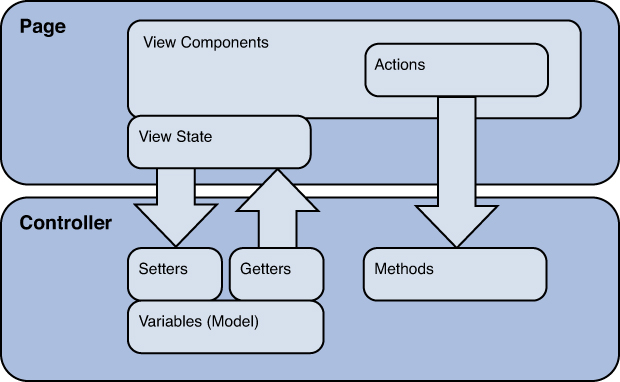Overview of Visualforce
Visualforce is a combination of a page containing the presentation and Apex classes containing the business logic. The presentation is usually HTML rendered in the Web browser, but Visualforce also supports content types such as XML and PDF. HTML output is typically interactive, building up state by collecting user input across a series of related pages.
Force.com processes Visualforce pages on its servers. Only the final rendered page and partial page updates are returned to the Web browser—never the raw data or business logic. Visualforce is driven by metadata. It can use the definition of fields in the database to provide the appropriate user interface, without custom code. For example, a Visualforce page with an input field mapped to a Date field in the database is rendered with a calendar picker component, consistent with the Force.com native user interface.
The architecture of Visualforce follows the Model-View-Controller (MVC) pattern. This pattern dictates the separation of presentation (View), business logic (Controller), and data (Model). In Visualforce, business logic and data are combined in the controller, named after its MVC counterpart. The presentation lives in the page.
Figure 6.1 shows the relationship between the page and the controller in Visualforce, as well as some of Visualforce’s internals.
Controller
The controller is Apex code that reads and writes data in the model, typically the Force.com database. The interaction of the controller with the user interface is accomplished through variables and action methods. Variables are exposed to the presentation layer through getter and setter methods. Getter methods allow the page to retrieve the value of a variable and display it for the user. Setter methods allow the user to modify the value of a variable through a user interface component such as a text input box.
Action methods perform the processing work on behalf of the user. They are wired up to buttons, links, and even asynchronous events on the user interface.
Force.com provides default controller implementations, called standard controllers. Standard controllers replicate the behavior of the native user interface, such as editing and creating records, but allow customization of its user interface without code. Custom behavior can be added to standard controllers using controller extensions, which are classes written in Apex. You can also implement a controller from scratch in Apex. This is called a custom controller.
Page
The Visualforce page defines the appearance of your user interface using a mixture of standard HTML and Visualforce-specific XML markup. The XML markup is used to add view components to the page. View components bind the controller to the page, defining how data and user actions are to be rendered in the user interface. Force.com provides a standard set of view components to support common HTML user interface patterns and supports user-defined components.
In Figure 6.1, the arrows between the page and the controller represent expressions. Expressions are embedded in view components to allow the page to reference methods in the controller or in system classes such as UserInfo. Expressions in Visualforce use the same language as formula fields in the database, with a special prefix and suffix added. For example, {!save} is an expression that invokes the save method of the controller.
Note
Visualforce maintains a strict separation of business logic and presentation. No business logic is allowed in a Visualforce page, not even for trivial formatting tasks.

